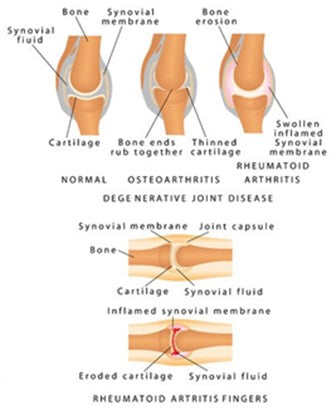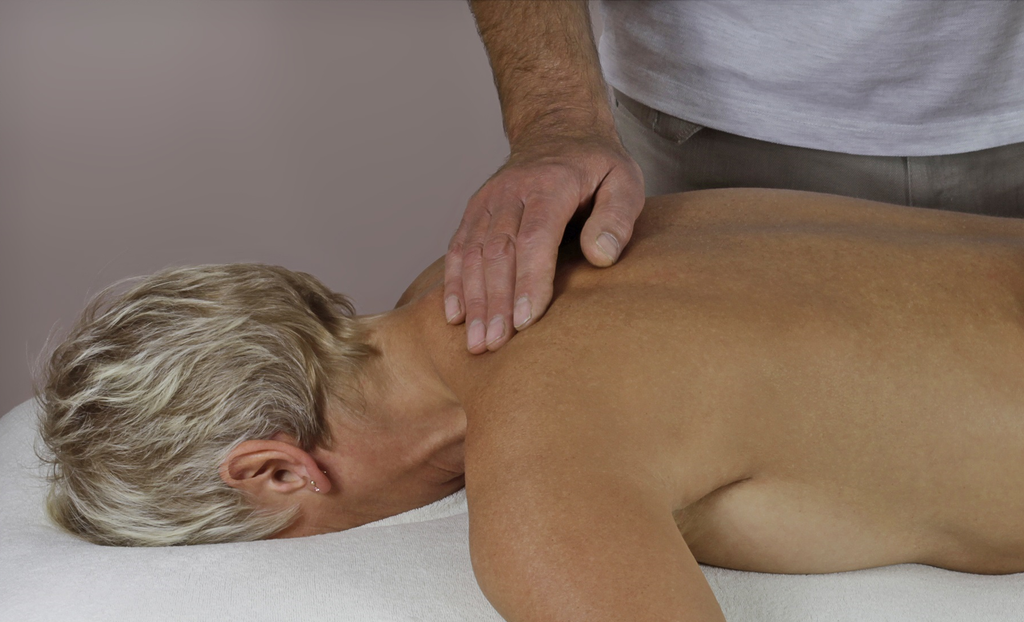Arthritis includes more than 100 diseases and conditions that affect joints, the tissues that surround the joint, and other connective tissue. Symptoms vary depending on the specific form of the disease, but typically include pain and stiffness in and around one or more joints. Some rheumatic conditions can also involve the immune system and various internal organs of the body.[i]
Arthritis affects more than 1 of 4 U.S. adults (that’s about 54.4 million people). It is a leading cause of work disability in the United States and one of the most common chronic conditions in the nation. Arthritis is a common cause of chronic pain.
There is a lot of conflicting information and little scientific research or published studies about arthritis indications and contraindications for massage therapy or bodywork.
Arthritis sufferers usually have a good deal of joint irritation and inflammation. As such, it is usually contraindicated to massage (or provide heat around) an “inflamed” area. However, some arthritis sufferers state that their pain is greatly relieved by heat, and there has been research over the years that shows heat was helpful with chronic medical conditions such as arthritis in SOME cases.
Some arthritic sufferers may find that a gentle massage therapy session could provide pain relief. Others could say this same work irritated their inflammation. It’s up to the bodyworker and client to evaluate and decide what services can safely be provided to that arthritic client.
The client usually knows what irritates and soothes them. It’s important to ask questions and listen to their answers because each individual usually knows their own body best. If there are ever any questions about safely providing service, it is best to seek physician approval and/or direction.
Osteoarthritis (OA)
Osteoarthritis affects over 30 million Americans and is the most common form of arthritis in the US. It is caused by the damage or breakdown of joint cartilage between bones. It is sometimes called degenerative joint disease or “wear and tear” arthritis. These changes usually develop slowly and get worse over time. It most frequently occurs in the hands, hips, and knees.
Osteoarthritis can cause severe joint pain, swelling, and stiffness. In some cases, it also causes reduced function and disability; some people are no longer able to perform their daily tasks and, in some cases, are not able to work. Severe cases may require joint replacement surgery, particularly for knees or hips.[ii]

Heberden’s Nodes
Heberden's nodes are often seen in osteoarthritis. They are hard bony swellings and growths that develop on distal interphalangeal joints. Precaution – do not press or apply pressure to swollen joints!


Bouchard’s Nodes
Bouchard's nodes are often seen in osteoarthritis. They are hard bony swellings and growths that develop on proximal interphalangeal joints. Precaution – do not press or apply pressure to swollen joints!


Rheumatoid Arthritis (RA)
Rheumatoid Arthritis, is an autoimmune and inflammatory disease, which means that your immune system attacks healthy cells in your body by mistake, causing inflammation (painful swelling) in the affected parts of the body.
RA mainly attacks the joints, usually many joints at once. These attacks are also commonly called “flare-ups”. In some cases, it may be contraindicated to work on a client while they are experiencing a “flare-up”. That’s because the client could have extreme irritation which might become worse by any type of pressure or touch. Unfortunately one of the only ways to know if their medical condition would be worsened by massage is through experimentation - and it would be unwise to experiment on clients. Also, just because a client has had massage in the past without irritation, does not mean they will have the exact same result with every massage session. Unfortunately we do not know why different responses can happen with what seems like similar massage sessions; and as such, practitioners should avoid doing anything where it feels like an experiment with a client where they could be worse off than before they started their massage or bodywork session. Just think of the old adage when performing massage or bodywork: do no harm!
It is up to the bodyworker and client to decide if they should proceed with service during a “flare-up”. It is always best to seek approval and/or direction for services from a medical physician regarding medical conditions if you and/or the client are unsure about which service(s) are safe and/or beneficial.
Rheumatoid arthritis commonly affects joints in the knees, hands and wrists. In a rheumatoid arthritic joint, the lining of the joint becomes inflamed, causing damage to joint tissue. This tissue damage can cause long-lasting or chronic pain, a lack of balance, and deformity within the joints themselves.
Rheumatoid arthritis can also affect the lungs, heart, and eyes. RA usually attacks many joints at once. [iii]
Fibromyalgia
Fibromyalgia is a frequently debilitating and painful condition that can have "tender points" on the body. Tender points are specific places on the neck, shoulders, back, hips, arms, and legs. These points can elicit extreme pain when pressure is applied to them.
The American College of Rheumatology approved new revised diagnostic criteria in 2010 for fibromyalgia that eliminated the 1990 tender point testing criteria.
The new 2010 diagnostic criteria uses the Widespread Pain Index, and symptom severity scale in place of tender point testing under the 1990 criteria.[iv]
The 2010 “Widespread Pain Index” (WPI) is shown here in the colorful picture of the body (top). The 1990 “Tender Point” criteria body chart is shown here with the red dots on the body (to the right).


As a bodyworker it is important to know where the “tender spots” are when working with fibromyalgia clients. It is questionable whether pressure should be applied to these tender point spots as this can be very painful for a fibromyalgia client. Always avoid working on any areas of lost sensation or numbness.
Fibromyalgia can also cause disability, a lower quality of life and widespread pain all over the body beyond the “tender points”. People with fibromyalgia may be more sensitive to pain than people without fibromyalgia. This is called “abnormal pain perception processing”. Fibromyalgia affects about 4 million US adults, about 2% of the adult population. The cause of fibromyalgia is not known, but it can be effectively treated and managed.vii

People with fibromyalgia can also be GREAT candidates for Massage Therapy!
The CDC reports US adults with fibromyalgia may have complications such as:
- More hospitalizations. People with fibromyalgia are twice as likely to be hospitalized as someone without fibromyalgia.
- Lower quality of life, especially for women. A woman with fibromyalgia has 40% less physical function & 67% less mental health than a healthy woman.
- Higher rates of major depression. Adults with fibromyalgia are more than 3 times more likely to have major depression than adults without. (Screening and treatment for depression is extremely important.)
- Higher death rates from suicide and injuries. Death rates from suicide and injuries are higher among fibromyalgia patients, but overall mortality among adults with fibromyalgia is similar to the general population.
- Higher rates of other rheumatic conditions. Fibromyalgia often co-occurs with other types of arthritis such as osteoarthritis, rheumatoid arthritis, systemic lupus erythematosus, and ankylosing spondylitis.[v]
Gout
Gout is a form of arthritis generally caused by a build-up of uric acid in the joint. It regularly starts in the big toe joint and other joints that are furthest from the heart where our body’s temperature is coolest, where the uric acid can “crystalize”.
Gout is considered one of the most painful kinds of arthritis. Symptoms include:
- Pain/tenderness
- Tightening of the skin
- Swelling
- Redness or discoloration
- Warm to the touch

Gout is generally caused by consuming purine rich foods, such as alcohol, anchovies, dried beans, gravies, liver and peas.
Most people who have gout are house-bound and are unable to stand or walk without extreme pain. It is ill-advised to press on the affected area, and it is recommended to seek approval and/or direction for bodywork from a medical physician regarding medical conditions. This may include rescheduling any services that involve the affected area (i.e., foot reflexology for someone who has gout in their big toe). Massage and bodywork services should never elicit extreme pain.

To learn more, please register for training at https://ceinstitute.com/
#massage #massagetherapy #massageprecautions #massagecontraindications
[i] Centers for Disease Control & Prevention. Arthritis. (2018, February 21). Retrieved May 03, 2018, from https://www.cdc.gov/arthritis/basics/index.html
[ii] US Health & Human Services. “Arthritis.” Centers for Disease Control and Prevention, Centers for Disease Control and Prevention, 3 Apr. 2018, www.cdc.gov/arthritis/basics/osteoarthritis.htm.
[iii] US Health & Human Services. “Arthritis.” Centers for Disease Control and Prevention, Centers for Disease Control and Prevention, 3 Apr. 2018, www.cdc.gov/arthritis/basics/rheumatoid-arthritis.html.
[iv] Wolfe, F; et al. (May 2010). "The American College of Rheumatology Preliminary Diagnostic Criteria for Fibromyalgia and Measurement of Symptom Severity" (PDF). Arthritis Care Res. 62 (5): 600–610. doi:10.1002/acr.20140. PMID 20461783
[v] National Center for Chronic Disease Prevention and Health Promotion | Division of Population Health. “Arthritis.” Centers for Disease Control and Prevention, 3 Apr. 2018, www.cdc.gov/arthritis/basics/fibromyalgia.htm.











